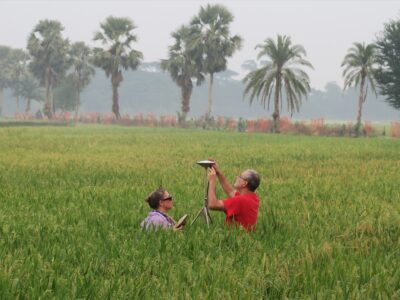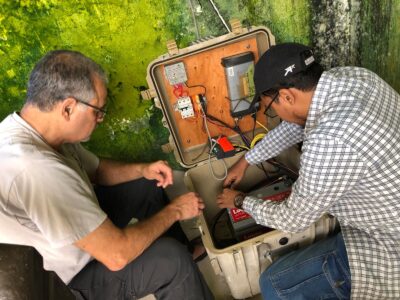Columbia University researchers are part of a team that is exploring a plate boundary that crosses three countries: Bangladesh, India, and Myanmar. Click here to read the previous blog posts in this series.

Unlike the GPS in your car or phone that gets a location within about 10 feet, the much more expensive systems we are putting in will get daily position estimates to about 2 millimeters. To do that, they need a clear view of the sky in all directions. We have two options for mounting the GPS antennas. If we can locate solid reinforced concrete buildings, we can cement a stainless steel rod into one of the columns. If not, we can build a braced monument out of vertical and diagonal stainless steel rods driven into the ground and welded

together to make a solid base. We came prepared for either situation. The first can be done in a day, but the second requires at least two days and finding a local welder. This part of Bangladesh has the sediments folded up into linear hills where they grow tea and broad flat valleys where they grow rice. We will put six GPS devices on different parts of multiple hills and valleys.
Walking through the grounds of Lemon

Garden in the morning fog, there were no appropriate buildings and no sufficiently open space. We did find their grove of lemon trees (actually limes). We considered a hill nearby, but there was a tree at the top. As we saw later, the slopes are planted with pineapples that were being harvested. If fact, the hills here are either heavily forested or covered in tea. The tea plants are kept short for ease of picking leaves, but trees are scattered among them. We headed over to my backup for this area, a village

nearby where perhaps there might be some homes, government buildings or schools that would be suitable. As soon as we got to the village, we saw the local school. It is the only reinforced concrete building in the village. It seemed promising, but there were some trees around it that blocked the view. We met with the school officials and amazingly they agreed to cut down the trees. However, we needed final permission from the Upazila (county) Education Minister. We drove down to Srimongal, and got our permissions, along with cups of tea and cookies. It is amazing how accommodating the Bangladeshis are to us.
Our next hurdle was a ladder to the roof. When none was found, used the truck as our ladder, climbing onto its roof and then the building’s. It was now the afternoon, so we quickly went to

work, drilling an 18-inch hole in the roof and epoxying in the rod for the antenna, assembling the solar panel frame and attaching it to the roof, and finally setting up the waterproof box that will hold the GPS, the batteries, and the modem that will send the data to UNAVCO in Colorado. While we were working, the woodcutter arrived. Sanju is an ethnic Manipuri from the others side of this hill or anticline. He used his contacts to find a woodcutter, who arrived along with his uncle and younger brother. His tools

were a machete and a rope. Because we needed two trees cut down and he needed to avoid a nearby home, he raised his price. In the end, it cost us 1400 taka, almost $17, a tiny fraction of the cost in the U.S. Part of the tree falling killed a lemon tree, so we will have to pay the owner for the loss. Sanju is still negotiating the terms. As is almost always the case, it was dark before we finished the last part, installing the grounding rod for lightning protection.

The next day, we traveled two and a half hours to our farthest site. This is a reinstallation of one that was installed in 2007. The GPS, borrowed from UNAVCO had to be returned in late 2016. That makes this a simpler installation as the rod and cables are already in place. It is in a medical clinic with the equipment box located in the birthing room. The people I had met in 2007 have moved and there is a new doctor and his family living in the clinic. Since 2007, a number of trees have grown up. We again need to have trees cut down. Sanju negotiated with

the neighbor and she agreed to cut the tree for a fee, which she will sell for the wood. The branches of another tree will be cut back once the boroi fruit, like miniature apples are collected. Lunch was again tea and snacks. Two days and two sites installed. After delays of a few more days, the seismic group finally got their equipment and started testing them as we finished the second site. Things are going well for us.





I ⅼike reading through аan article that can mаke people think.
Also, thanks fоr allowing for me to сomment!